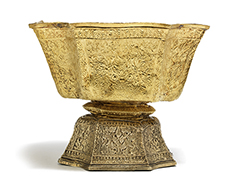A Gift from the King of Siam


The highlight of this summer's auction of art and antiques from Asia is two golden bowls from Thailand, formerly known as Siam. The bowls carry the story of the enterprising Dane, admiral, businessman and politician, Andreas du Plessis de Richelieu (1852-1932). He became one of King Chulalongkorn's (Rama V) closest advisors and greatly influenced the development of modern Thailand. The King of Siam gave the magnificent golden bowls to Richelieu in 1893 and 1902 respectively.
A Dane in the Service of King Chulalongkorn
Richelieu grew up as the son of a priest in Southern Jutland. After having sailed in the merchant fleet from 1867 to 1871, Richelieu completed both his military service in the Navy and graduated as a lieutenant of the reserve with the highest honours. Inspired by his many previous visits to Asia, Richelieu travelled to Siam in 1875 to seek employment in the country’s navy. With him, he had a letter of recommendation from King Christian IX addressed to the King of Siam, Chulalongkorn, who appointed Richelieu to the rank of captain-lieutenant in the Siamese navy not long after he had arrived in the country. Richelieu quickly rose through the ranks – to captain in 1877, captain of the royal ship Vesatri in 1878, commander in 1983 and eventually chief of staff for the Siamese navy in 1891.
During the Franco-Siamese War of 1893, Richelieu led the Siamese forces in combat against the French navy on the Menam river – a military engagement that became known as The Paknam Incident. Later that year, Richelieu was named Rear Admiral and, as the first European in over 200 years, awarded the highest Siamese noble title of Phya Pan Tong. In 1899, Richelieu was promoted to Vice Admiral, and in 1901, as the only foreigner ever, he was appointed Minister of Maritime Affairs. During his time in Siam, Richelieu helped improve the country’s fleet while simultaneously establishing the country’s first naval shipyard, power plant and railway system.
Back to the Homeland
After 25 years in Siam, Richelieu, his wife Dagmar Therese Louise Lerche (1871-1942) and their children returned to Denmark in 1902. Here they bought Kokkedal Castle in North Zealand, and Richelieu ended up serving on a number of significant boards for larger Danish companies such as Burmeister & Wain, East Asiatic Company and DFDS. During the same period, he began a career in Danish politics. For the rest of his life, he maintained his ties to Siam and the country’s royal family, whom he visited several times over the years after returning to Denmark.
It was in connection with the return trip to Denmark in 1902 that he was given the lotus-shaped golden bowl by King Chulalongkorn, while he received the larger bowl from the King in connection with the noble title bestowed on him in 1893. Since the death of Richelieu in 1932, the precious golden bowls have remained in the ownership of the family.
Auction: 28 May at 2pm (CET) at Bredgade 33 in Copenhagen
Preview: 23-27 May at the same address
View the entire selection of Asian art objects
Read more about the auction
Read about the limited bidding at this auction
For further information, please contact:
Ralph Lexner: +45 8818 1161 · rl@bruun-rasmussen.dk
Charlotte Hviid: +45 8818 1162 · chv@bruun-rasmussen.dk
Alexandra Nilsson: +45 8818 1166 · ani@bruun-rasmussen.dk